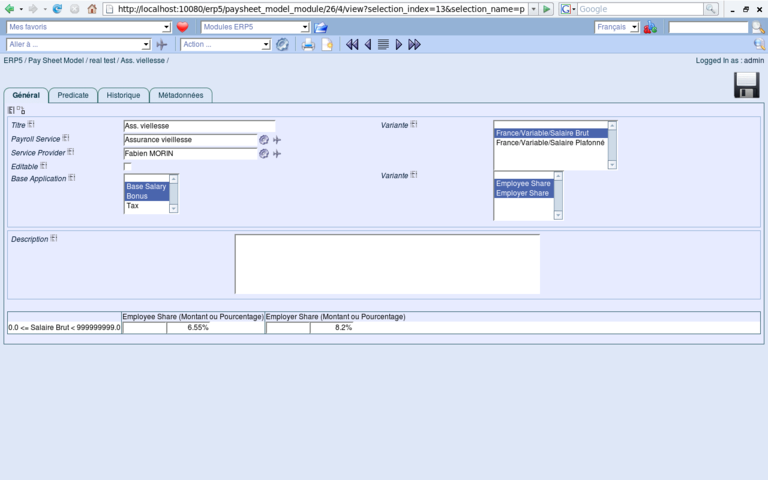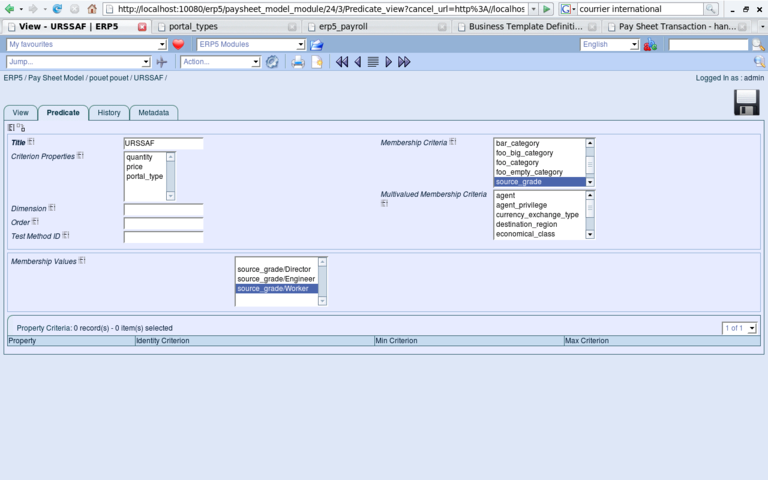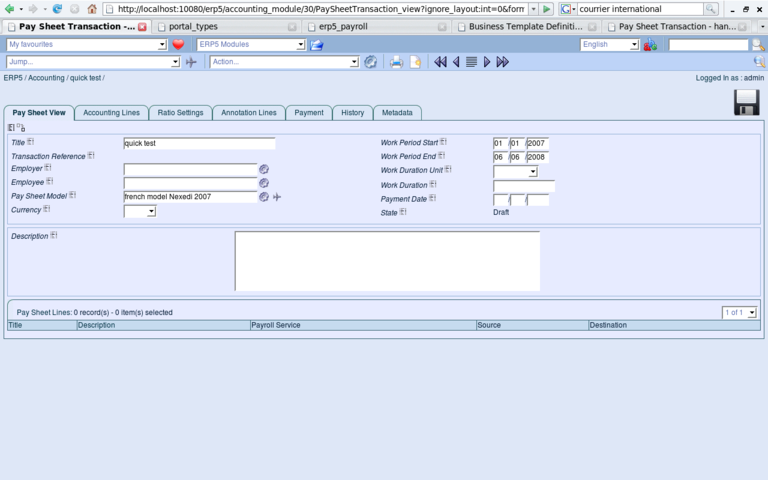ERP5 Pay Sheet have changed and now use a Pay Sheet Model. A Pay Sheet Model
permits to define some parameters specific to a country, a company, employee
group, or a single employee. It's used to describe the common parts in several
pay sheets and the method to calculate the elements. It could be applied on many
employees or just on one. The model makes easy to create slices, constants,
payment conditions or annotations and modify the values if they change. This
module has been developed to ease the work of accounting when the laws (and
therefore the calculations) are changing and to have the least possible modification
of the source code. It can also generate the Pay Sheet of a group of employees
from the same model.
Table of Contents
Steps¶
In calculating the paysheet, many elements depend on the legislation of the
concerned country. That is why it was chosen to separate the initial Business
Template (bt) in several bt's:
-
A generic bt, which contains no information of specific legislation:
erp5_payroll
-
A bt for each legislation with the specific data used by it (e.g. :
erp5_payroll_l10n_fr for France),
-
A bt for each project containing the datas used by this project (payroll
services, organisations, ...), (e.g. : nexedi_payroll
for Nexedi project).
Specifically, the informations that may vary from one country to another are as
follow:
- the slices,
- the Delivery Builder (pay_sheet_transaction_builder)
- /!\ add here the future things...
The informations that vary from one project to another are as follow :
- the payroll services,
- the organizations (used in payroll service),
- the Rules (Invoice Transaction Rule)
- the categories including :
- the slices (salary_range category),
- the employees grades (grade category),
- tax_category can be added to have more part than employer and employee (tax_category category).
Create a Business Template for my country¶
If you need slices to calculate pay sheets in your country (general case),
create a category (in the 'portal_categories' module) for your
country. In this category, you will create sub categories :
You must create as categories as different amount slice you have. (more
explaination in 'Create Payroll Services').
After that, create a bt for your country (respecting the naming convention so
call it erp5_payroll_l10n_YourCountryCode e.g. : 'erp5_payroll_l10n_fr'
for France). Add slices used for pay sheets in your country in the 'Paths'
LinesField of the bt.
Create a Business Template for my project¶
Create Payroll Services¶
You must create as many Payroll Service as there are contributions on pay sheets
to create : a line of pay sheets = a payroll service. In the payroll service,
some parts are important and new :
-
The Base Participation it's an amount type list. It's used
to define the amount group this contribution belongs to. A contribution can
belong to several amounts:
-
The base salary contributes to the Gross Salary and to the
Base Salary groups (because the gross salary is composed by the
base salary + the bonus) . Also a bonus contributes to Gross Salary
and Bonus groups. But a tax generally contribute only to
deductible or non-deductible taxes group.
-
Variation Base permit to select the base categories which
will help define the rules for calculating the payroll service. I recommend
always select tax_category and salary_range which will
allow you respectively to select the parts (employer, employee, etc.)
and the slices used.
-
After your Variation Base selection, you must save your data to see the
Variation Range.
-
Variation Range permits to select the slices and parts used.
Normally, there is no yet slices, you must add the one you want to use. To do
this go to 'portal_categories/salary_range' and create slices. A
Slice is composed by a min and a max value, so you must create as categories
as min an max values (but min and max values are not entered here. I'll
explain that later).
e.g : In France, a lot of contributions used this 3 slices :
0 <= Tranche A < 2682
2682 <= Tranche B < 10728
10728 <= Tranche C < 21456
So we are going to create 3 categories : 'Tranche A', 'Tranche B', 'Tranche C'.
(Adapt it to your legislation).
Repeat this process for all the slices required to calculate all your paysheet.
I recommend that you create a generic slice (call it 'infinty_slice' for example)
that you add to each of your services that do not use slices. Later, you will
define value from 0 to a very big number for this slice, which will remains
the same as if there were no slice, but simplifies the operations of the program.
When you have all slice you need, continue creating your Payroll Service by
selecting the slices used for this contribution and the different parts
(Employer Share, Employee Share, ...).
Create Portal Rules¶
Go to 'http://yourInstanceAddress/portal_rules' and add a new
Invoice Transaction Rule. Call it 'default_pay_sheet_transaction_rule'.
Then add the Predicate and configure the behavior for the different shares and
services.
Add Employees Grade¶
If your company use grade, it may be a good idea to add the different grade
category in 'portal_categories/grade'. That will permit to use a
predicate to apply a paysheet model only on a certain grade.
Create the new Business Template¶
Then, create a new bt for your project (call it YourProjectName_payroll e.g.:
'nexedi_payroll'), see
HowToCreateBusinessTemplates for help. Now you are ready to follow the next
HowTo : HowToCreatePaySheet.
Principles of Inheritance(from notes)¶
A new concept that make the new Payroll module very more usable is the
Inheritance principle :
A PaySheet inherits from a model, and this model could inherit from some other
models wich could inherit from other models ... In a company, this permit to
seperate contributions who are applied in certain condition (eg. for a precise
employee group), this could be representated with the following schema :

Create a Pay Sheet Model¶
In first, you must install the 'erp5_payroll' Business Template, and the
corresponding localized Business Template (e.g. : 'erp5_payroll_l10n_fr'
for France), if it does not exist, it is recommended to create it by using
the following tutorial: HowToMyCountryPaySheet. After installing the
'erp5_payroll' and localized Business template, the first step is to
create a model.
Add Pay Sheet Model¶
Go to the Pay Sheet Model Module and 'add Pay Sheet Model' from the action menu
and filled the fields.

The employer, employee and currency will be copied in the pay sheet if those
here are empty. If Absolute Payment Date is filled, it will create a Payment
Condition with it. The Work Duration Unit and Work Duration are used to indicate
the worked time for this period. An Annotation Line is created, when these
fields are filled. Annotation Lines are designed to display informations on pay
sheets, but at the moment they are not yet used in the rendering of it. Settings
Categories are the base categories used to create the slices. It corresponds
more or less to the laws of that model. A country contain only slices categories
used in this particular country. It is possible to add a category and the slices
for your country or category for your business. To do this, go to the
'portal_categories' module and add sub-categories in the salary_range category.
When this first page is filled, save your data.
Select Categories¶
After that, if you selected something in the Settings Categories you must
see new lines in the Settings Slice tab.

These new lines correspond to slices that it is now possible to use. You must
define a minimum and maximum value for each of the ones you want to use. The
slices objects are created when you save. If you want, you could now add some
Annotation Lines, Payment Conditions or Ratio Settings but it's not necessary
for a minimal Pay Sheet Model.
Add Model Lines¶
After completing the fields of the model, we must add Model Lines representing
the contributions that you want to appear on the pay sheet. To add a Model Line,
use 'Add Model Line' from action menu.

Now You must select the Payroll Service corresponding to the contribution you
want to add. If it doesn't exists, add it (don't forget to select slices in
variation range if you want to use slices with this contribution). The Service
Provider is the organization who collects the tax (a contribution is generally
the payment of a service, social or otherwise..., it's this organization account
that will be used in the accounting calculations). If the Editable check box is
checked, that's mean that the amount/percentage will be (re)asked at the
calculation step. This permits to use a same model with many employees although
some values vary from one employee to another.
The Base Application is used to set the amount on which the contribution will
be applied.
e.g. : We have a contribution called "old age insurance" wich is 6.55 percent of
the gross_salary for the employee and 8.20 percent of the gross_salary for
employer. To represent this contribution, we can create a new Model Line and
filled Title, Payroll Service and Service Provider. In the Base Application List
Field, we select 'Base Salary' and 'Bonus' because the gross salary is composed
by this two elements. In the Variation Parallel List Field, we select the good
slice and the good shares (here it's 'Employer Share' and 'Employee Share').
After saving, a matrixbox should appear on the bottom, here, we can fill the
two fields 'Percentage' of the 'Employee Share' and 'Employer Share' with the
6.55 and 8.20 values. This mean, this contribution will be 6.55% of the gross
salary for employees and 8.20% for employer.
If the contribution that you are adding is applied to nothing (such as salary,
for example) do not select anything. The amounts of the Base Application are
determined at the calculation step with selected categories in the Base Participation
list in the Payroll Services. When this is done, save your data. If your Payroll
Service has slices selected in the variation range, you must now see those same
variations that can be used for this contribution. Select the ones you want,
and save.
After this, you must see some new lines at the bottom of the page. This ones
corresponds to rate or share to applied in this slice. If your contribution
depend on a percentage of an amount, just fill in the 'percentage', if the
contribution is an amount, fill just the first column.
Now your first model line is created. I recommend to add others, such as one
concerning the salary (and whose Base Participation of Payroll Service is
base_salary) if no service with the base the contributions apply to is used,
then the amount of pay sheet lines likely to be null.
Set Conditions¶
After completing and registered your line model, you can, in the 'Predicate'
tab, define the conditions in which this contribution will be applied.

This allows, for example, to use the same model for one company, with a predicate
for director, worker and engineers. If this contribution have a predicate with
just Worker, that's mean, at the moment of the calculation, only person with
grade 'Worker' will have this contribution applied.
Create a Pay Sheet Transaction¶
Add Transaction¶
Go to the Accounting Module and 'add Pay Sheet Transaction' from the action menu
and filled the fields.

If you have well completed your model, you do not have a lot of fields to be
filled, only the title, start/end work period and the model you want to use
are needed. Once these fields are completed and saved, you can use the function
'Apply Pay Sheet Model' from the action menu, which would fill in the missing
fields and copy the sub objects in the model (such as Annotation Lines) in the
payroll. If everything looks correct, then you can start the calculation with
the 'Calculation of the Pay Sheet Transaction' from the Action menu. After this,
if you have check some editable check boxes, the corresponding value will be
requested, after filled them, click on 'Calculate The Pay Sheet Transaction'
to have the pay sheet lines.
Related Articles¶